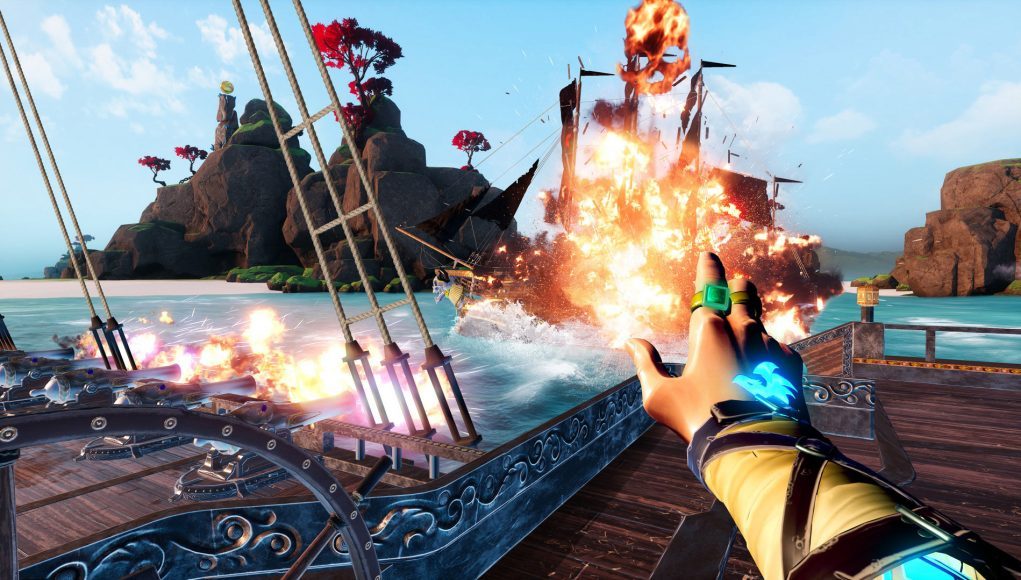Battlewake is a pirate ship combat game that seems to have it all; not only does it boast a campaign for both solo and two-player co-op, but also online PvP and a co-op ‘ongoing missions’ mode—certainly nothing to sneeze at in terms of a VR game. All of this ultimately gives it a more secure footing where multiplayer-only titles may have faltered in the past, but some might still walk away from this mostly well-polished arena battler craving something just a bit deeper.
Battlewake Details:
Developer: Survios
Available On: Steam (Vive, Rift), Oculus (Rift), Viveport (Vive, Rift) PlayStation Store (PSVR – EU version coming soon)
Reviewed On: Rift
Release Date: September 10th, 2019
Price: $30
Gameplay
Let’s get one thing out of the way before heading into the review proper: Battlewake is not Sea of Thieves in VR. Although there’s a lot of interesting things going on with this plucky little arena battler that may seem like they would translate to a larger, more expansive title, Battlewake decidedly focuses on discrete nautical arenas where you battle in a ‘one person, one boat’ style experience. It’s different, and not in a bad way, although you should definitely tailor your expectations before heading in. Now, on to the review.
Battlewake’s 20-chapter campaign follows the story of four captains, each of which has their own specific boats, weapons, and two levels of ultimate attacks—one that charges up more rapidly for smaller and more frequent attacks, and the big boy that eventually lets you spawn massive area-based effects like hurricanes, krakens, and title waves. And for whatever critique that follows, ultimates are unequivocally awesome.
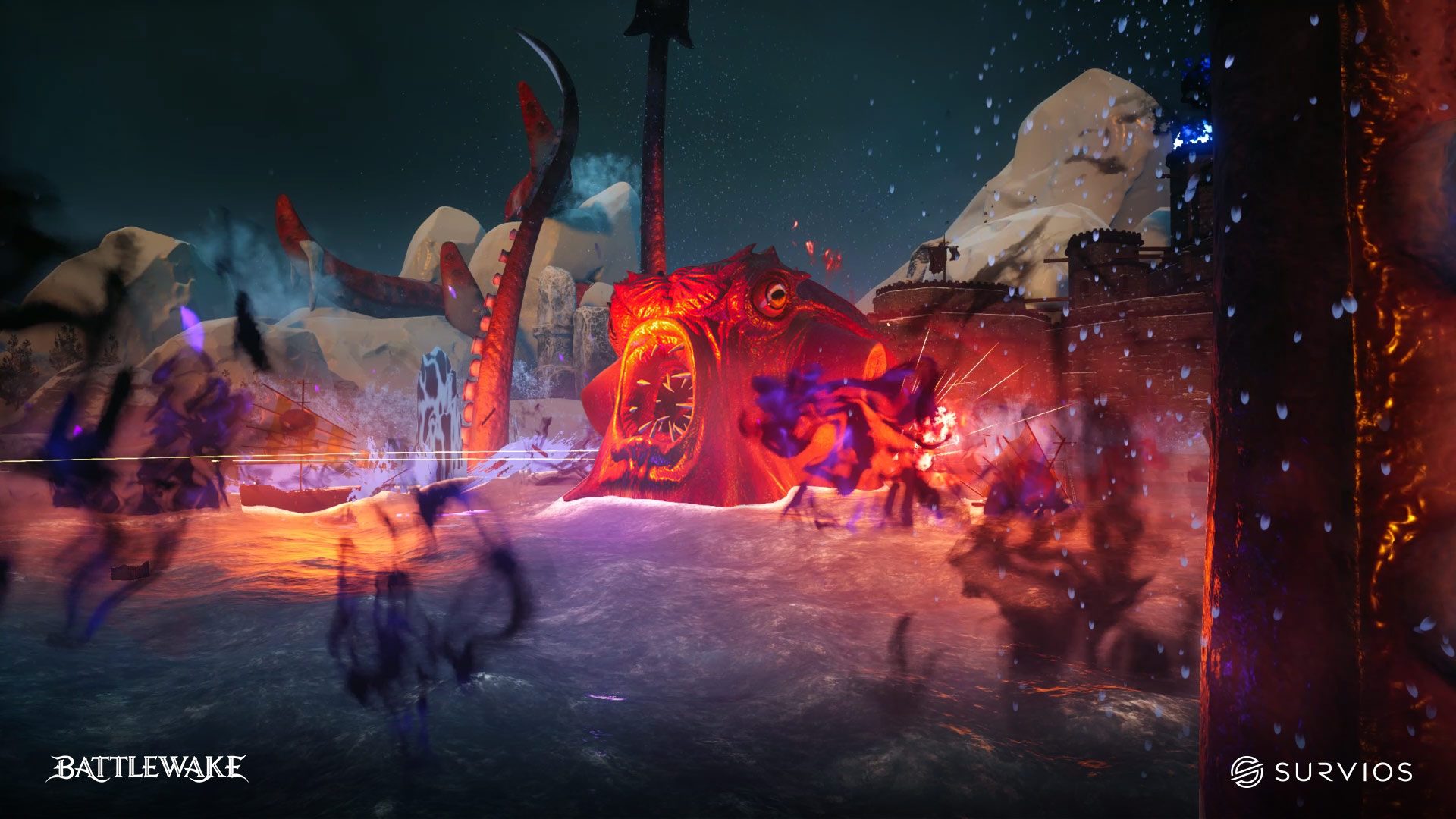
Campaign mode promises a variety of medium-sized arena maps, but they basically fall into four categories: tropical, icy, swampy, and volcano-hellscape. Most maps present their own environmental quirks too—swamps provide better cover, volcano-hellscapes assault you with raining debris, icy maps have giant floating icebergs, and the tropics can get pretty stormy, generating large waves capable of obscuring potential targets at times. You don’t need a compass or anything to find your way around either because the maps are small enough so you’ll never get lost. If you happen to have your back turned to an objective, a floating symbol will tell you which way to go.
Although the later stages do present more of a challenge, I only ended up dying twice throughout the entire campaign, which took me exactly two hours to complete. I chalk these deaths up to initially misunderstanding how the targeting system works; it requires you to physically point either your left or right hand at the enemies, lock on to the target while tracking it, and wait for the reticle to shrink and pulling the trigger, signifying that you’re getting the most accurate shot possible. Ammo is infinite, although there’s a cool-down time for most weapons, which typically include a weak forward-facing gun, stronger cannons or ballistas on your two sides, and a closer range weapon on your rear.
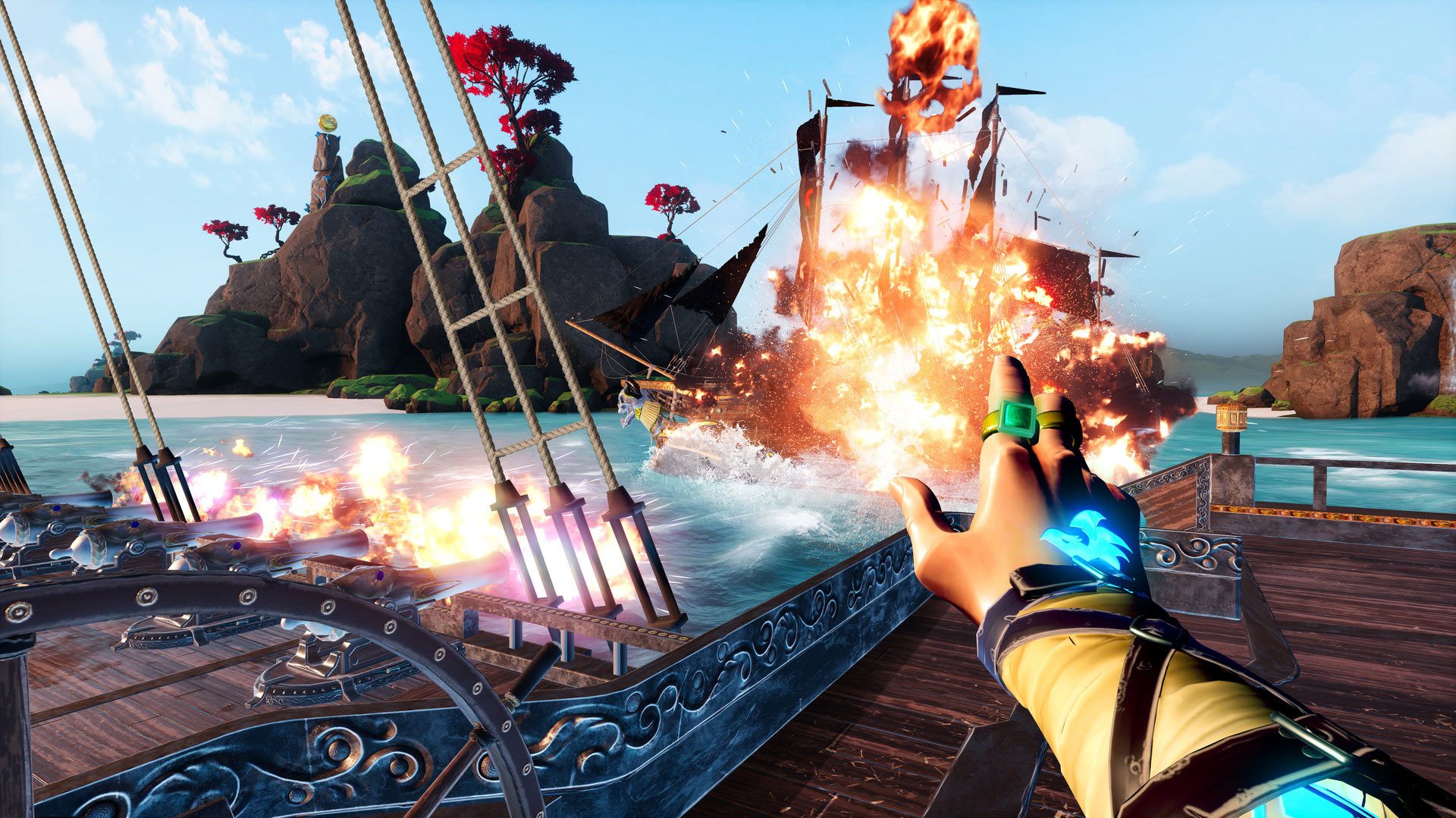
I’ll talk more about the control scheme in the Immersion section below, although it was ultimately an easy way of shooting and navigating the boat that I think anyone can pick up in short order.
With no apparent difficulty settings, and the ability to pick up health from the crates that enemies leave in their wake as you damage them, the campaign turned out to be fairly easy once the controls schemes became second nature.
Enemy variety is however pretty lackluster, and includes small kamikaze-style vessels, a few unremarkable boats of varying sizes, and either a large boss boat or an island fort, each of which have more health and their own unique ultimate attacks to avoid. Outside of lining up correctly to target any given ship, you don’t really need any special tactics to kill anything in the campaign; just point, click, shoot, rinse and repeat.
If I don’t sound too hot on the campaign, that’s because I’m not. I felt like it could have woven a more engrossing story than the disembodied (and admittedly talented) voice actors provided. It also could have offered up some deeper gameplay to break up the standard flow of arena-based missions. Instead, you’re left with a one-way trip through a pretty predictable premise that felt like more of an extended tutorial than anything else. You don’t make any game-changing decisions, you definitely never leave your boat, and you just sort of sample what the game’s multiplayer has without really engaging with the story or anyone in it.
Adding insult to injury: after beating the last boss, which was only marginally more difficult than the previous one, you’re abruptly thrown back into the captains lodge for an unceremonious ‘You won! Thanks for playing!’ and a credit roll. It’s a shame the game ended so easily and with such little fanfare; there’s truly a lot going on for Battlewake when it comes to locomotion, environment, and its awesome ultimate powers, but the entire campaign felt pretty unremarkable.
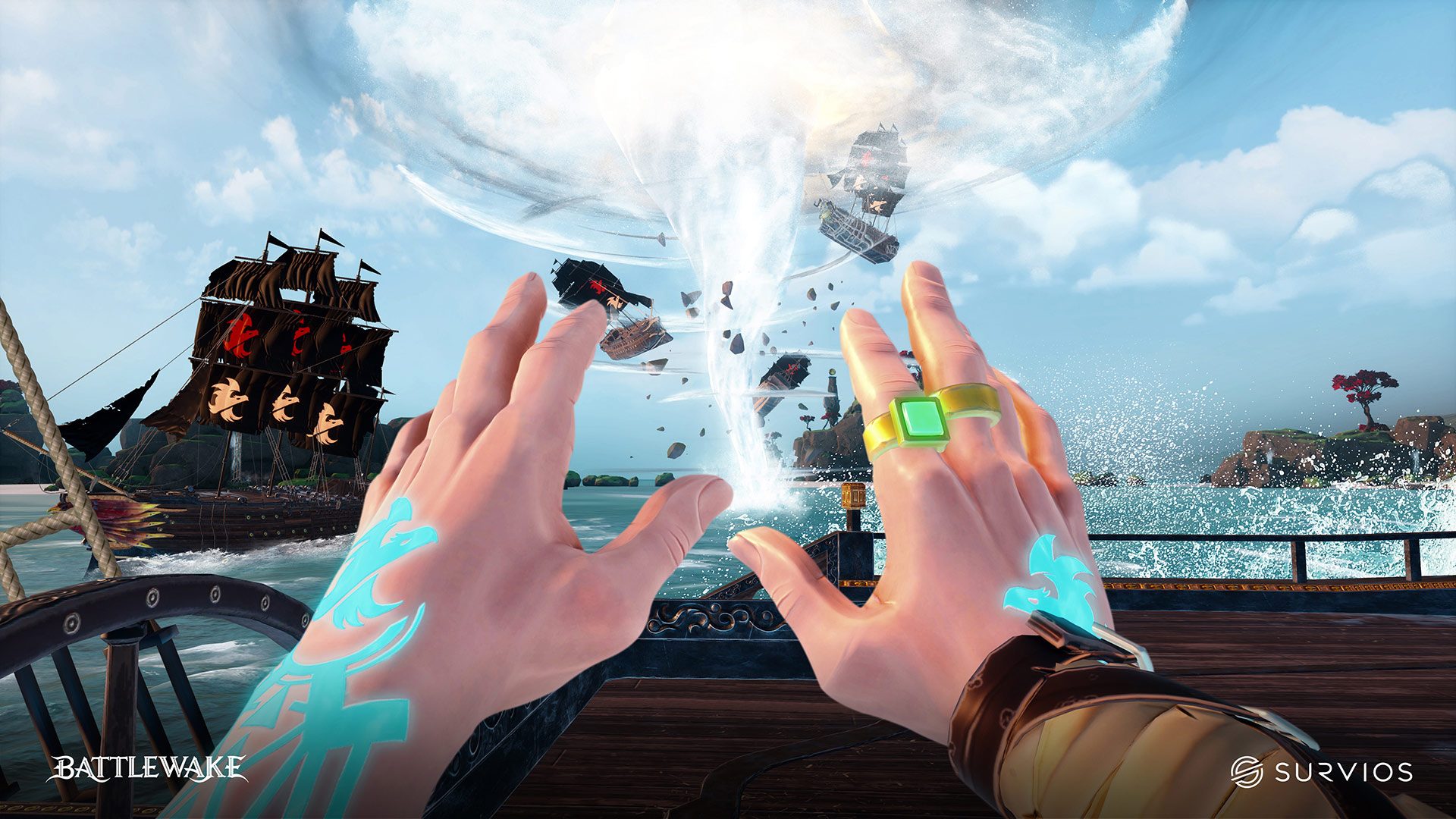
The campaign isn’t everything though, and outside of the story mode, replay value comes in one of three flavors. You can co-op with up to four people in the infinite mix of objectives called ‘Warfare’, play in a 10-player online deathmatch called ‘Plunder’, or alternatively return to the campaign with a buddy for a two-player co-op run.
Warfare mode presents you two specific currencies. Tankards of grog are dolled out after each completed mission, and you can use that to continuously level up your ship’s basic HP, firepower, and ultimate power, all of which helps you battle the increasingly tough enemies. Coins can also be earned to be used on permanent upgrades too that you can carry over to deathmatches, although they’re harder to gain than grog in general thanks to ever-increasing unlock prices.
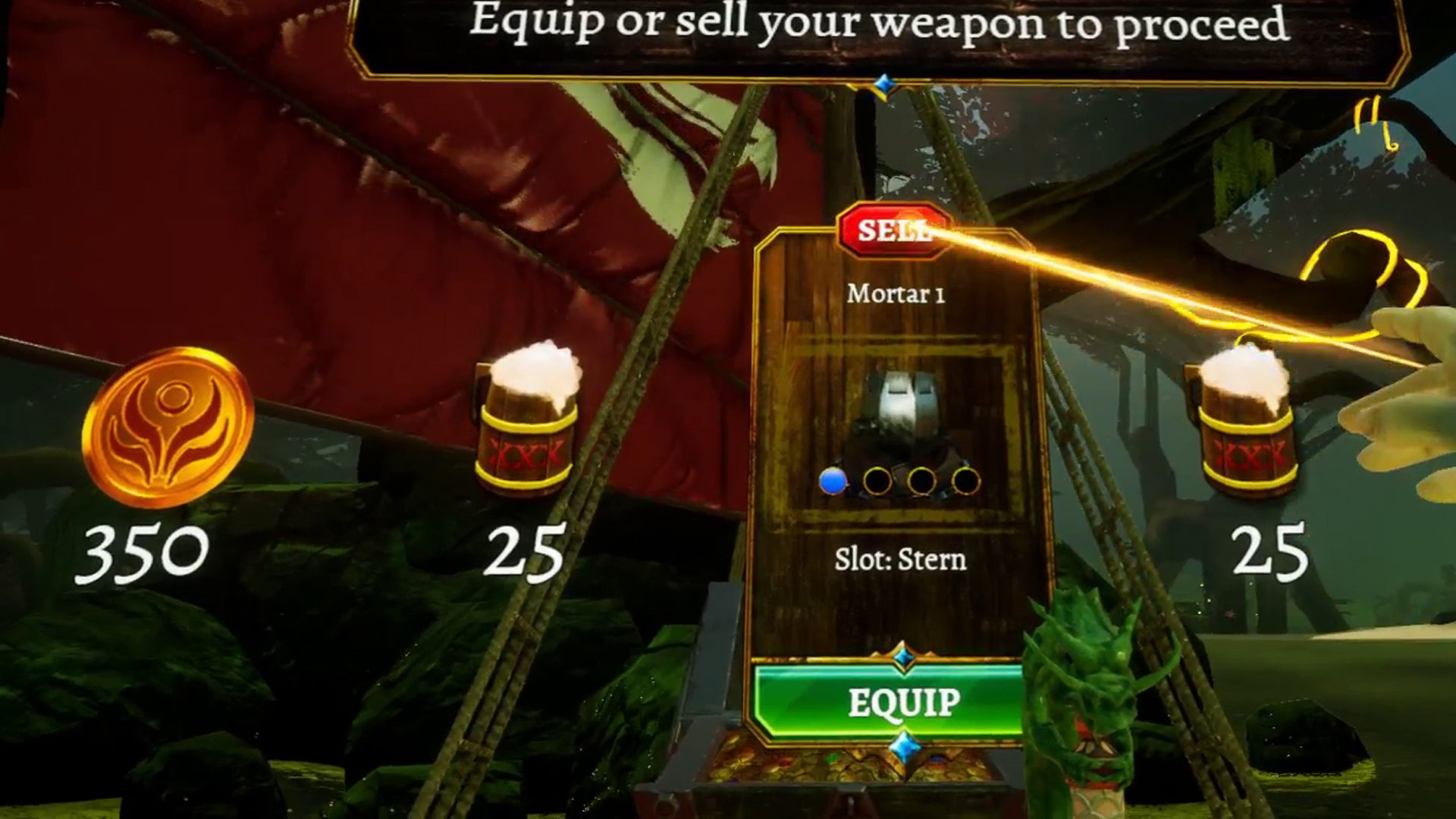
I took a little while to gel with Warfare. Even playing with another person for a good 30 minutes, it ultimately felt more like a casual shoot-out than a real challenge. Going in with the max number of people does provide the best chance for competitive friction to occur, although Warfare may really only be valuable for farming XP and maxing out your ships for PvP. While you can technically play Warfare by yourself, it’s definitely more fun with a few other people, as you scramble to make the most kills and subsequently get the best loot at the end of the mission.
The ‘Plunder’ PvP mode instead presents a pretty standard shooter formula, as it puts ultimate boosters in specific spots on the map, and has up to 10 players duke it out. It is does diverge slightly from the formula though, as you can always tell where other players are on the map; you see both their name and health bars at all times, even when they’re camping behind a rock.
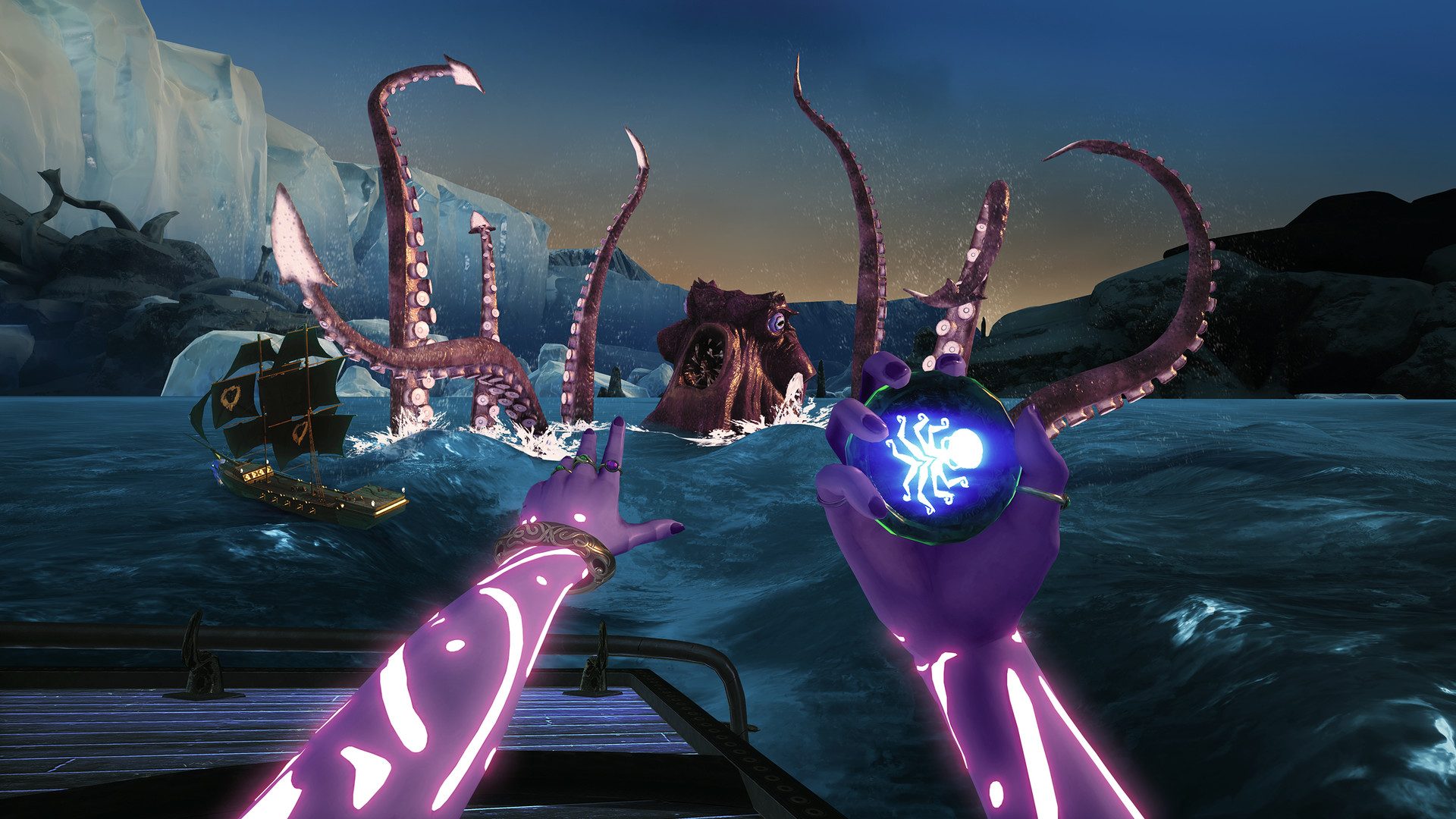
Here, the power differential truly counts. The more you play deathmatch or Warfare co-op, the more coin you can potentially earn, thereby letting you permanently upgrade any one of your four ships. Some ships are by default better at long-range shooting, and others have more powerful closeup shot—pretty much what you’d expect from a bog standard free-for-all shooter.
If you’re looking for some uncomplicated PvP and a few random missions to play to fill out, Battlewake may not be a bad choice, but more variety could have ultimately added a ton of value to what, at least functionally, is a well-polished and functional pirate game.
In the end, Battlewake might better appeal to arcade audiences and new VR players, as its simple control scheme and uncomplicated gameplay makes for a good entry point into VR. At-home users who are mostly already over the VR honeymoon phase however may find Battlewake interesting, but too simplistic to truly warrant the repeat business VR multiplayer titles desperately need.
Immersion
One of the most (and arguably least) immersive bits about Battlewake is its control scheme. Some controls are based on direct object interaction, which generally feels pretty great. You can turn the wheel to maneuver the ship, and pull either of your lateral anchor handles to execute a tight turning maneuver; both offer a surprisingly satisfying way of guiding your ship through tight passages and scrambling to get out of the way of an oncoming kamikaze ship.
At the same time, there are a few less immersive controls here too, namely the reticle-based shooting system that activates different weapons depending upon where you’re trying to shoot. It’s all a bit of a strange mix, having physical controls mashed up with what essentially amounts to an abstracted laser pointer that comes from your hands. I know it’s done for convenience and ease of use, although the most convenient control isn’t necessarily the most immersive, I find. It’s definitely a balancing act, and I admit I’d rather have a quick and dirty solution for fast action than a slower solution when you’re in the heat of the moment, which in and of itself is a type of immersion too. When you stop thinking about the empty teacup on your desk and knock it over because you’re frantically turning your steering wheel like a madman, that means the game has done a pretty good job of immersing you, at least in the short term.
Both the art style and map designs are cohesive and well-built, although textures are a bit on the muddy side. As a separate issue, a VR headset with a sharper display than my standard OG Rift would also be a boon for anyone looking to play Battlewake, as distant enemies and environments can be hard to make out. While playing in Warfare mode with a friend in a Valve Index, it was immediately apparent that I was at a slight disadvantage in my Rift, as he had an easier time identifying baddies than me and therefore prioritize higher value targets better.
Comfort
Like all of Survios’ titles to date, Battlewake explores some pretty interesting territory technically speaking. I played for several hours at a time, and never felt a whiff of motion sickness, which is quite a feat for a game set entirely on a swaying, rocking boat.
Unlike a physical boat though, which can definitely upset the stomachs of motion sickness-prone users, Battlewake surprisingly provides a comfortable user experience. This is because you’re not exactly tied to the mast, so to speak, and you’re not exactly taking on the full brunt of the sea’s forces.
Instead, you’ll notice that as waves get worse, the ship will actually move somewhat independent from you, giving you more stability as a result. This can be irksome when you’re reaching down for the anchors, only to find they’ve moved a few inches behind you because the waves are tossing you so badly, but I’d rather take a look to relocate a handle than lose my lunch.
Snap-turn is also available so seated players can keep a better eye on their six without having to physically turn around.
Finally, Survios has implemented an optional FOV limiter that creep in to gently obscure your peripheral vision—or whatever’s left of it in the cramped confines of the VR headset. This helps to reduce the apparent motion you naturally sense when near-field objects whiz by you.

